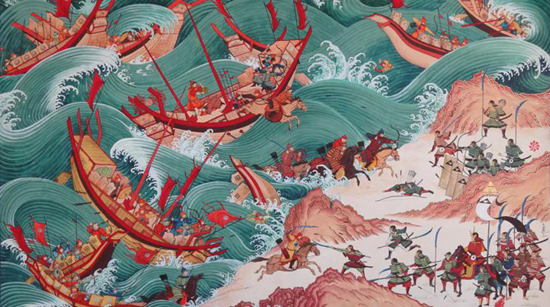
Everyday weather has a tremendous impact on day to day life. While it generally tends to just slow down our commutes or affect our picnic plans, extreme weather can flip the tides of a war or bring a civilization to its knees. Weather doesn’t take sides, and the world as we know it would look awfully different if not for its interventions.
10. The Kamikazes
The divine winds we’re talking about here aren’t the suicide pilots of WWII, but the powerful monsoons that shook Japan’s coast in the 13th century. Genghis Khan’s grandson, Kublai Khan, had taken the throne of the Mongol Empire, defeated southern China and united the country under the newly formed Yuan Dynasty. He then set his sights on the islands of Japan.
After several unanswered attempts to persuade the Japanese Emperor to surrender, Kublai amassed a large force and attacked. In 1274 he began his offensive with 40,000 men and 900 ships. Leaving the Korean peninsula, they arrived at the southern tip of the island of Kyushu and came face to face with 10,000 samurai. The Japanese bushido style of combat was utterly unsuited to fighting the Mongols, but a powerful typhoon struck the coast and destroyed the attackers’ fleet and most of the army.
Seven years later, Kublai Khan brought together an even larger force of 140,000 soldiers and 4400 vessels to take the islands once and for all. The typhoon intervened again, wrecking all but a couple of hundred ships in a furious storm. The survivors were little match for the better prepared Japanese.
9. The Battle for Long Island
During the American Revolutionary War, General George Washington was leading 19,000 troops in the defense of New York City in the summer of 1776. After the British left Boston in March, they arrived at Staten Island and made their headquarters there in July. Over the following weeks their numbers bolstered to up to 40,000.
Not sure where they would attack first, Washington left half his forces in lower Manhattan and moved the rest to Brooklyn and Guam Heights on Long Island. On the 22nd of August, the British landed in Gravesend Bay. Thanks to loyalist informants, the attackers discovered an unprotected path through the Guam Heights that would take them right into the heart of the American forces. On the 27th, the British charged the defenders, who quickly realized their dire situation and began their retreat to Brooklyn.
Under the cover of darkness and with the help of some locals, the Americans managed to slip away unnoticed to Manhattan via the East River. The British, stationed only a few hundred yards away, were totally unaware because of a dense fog which settled on the bay in the early hours of that morning. Eyewitness accounts mention George Washington being among the last to retreat. If it wasn’t for that mist, chances are that General Washington would have been captured and the war would have taken a very different turn.
8. The Mayan Decline
The Mayan civilization was one of the most prominent Mesoamerican cultures. Existing as early as 1800 BC, they reached their peak around 800 AD. During this time they built over 40 cities and mastered mathematics, astronomy and calendar keeping. They also practiced agriculture, but in a slash-and-burn style that cultivated mostly corn, beans and squash.
After around 900 AD, little evidence of other advancements exist and most of their cities were abandoned. Historians are still unsure what happened, with some blaming civil unrest or warfare. More recent evidence points to long periods of drought brought on by heavy deforestation - since most of the Yucatan peninsula relied heavily on rain for its water supply - a drought that spelt disaster and brought even the mighty Maya to their knees.
7. Failed Attempts to Invade Russia
We think by now the Russians are accustomed to the idea that pretty much no one can invade their country. With the exception of the Mongols, who successfully conquered Russia in the beginning of the 13th century, no other force was able to do so thanks to the extremely harsh winters the region experiences almost every year.
The first to try was King Charles XII of Sweden in the winter of 1708-9 during “the Great Northern War.” He led a sizable force from Saxony to conquer Moscow, but was stopped in his tracks because of the losses sustained during one of the coldest winters in modern European history.
The same thing happened to Napoleon in 1812. Of his 600,000 men only about 100,000 managed to return to France, while the rest died of starvation or exposure to the elements. This defeat, inflicted in part by the Russians and in part by the weather itself, changed the course of history.
Adolf Hitler apparently forgot the lessons taught by the aforementioned leaders, since he made the same mistake. In the winter of 1941, German forces trying to conquer Moscow and Stalingrad were all but wiped out by the bitter cold and constant attacks from the Soviets. This marked the beginning of the end for the Third Reich.
6. Donora Smog Disaster
In the late days of October 1948, disaster struck the town of Donora, Pennsylvania. A weather phenomenon known as “air inversion” hit the town due to a flux of cold air coming from the west. Located within a valley and surrounded by peaks towering some 400 feet, Donora offered the perfect conditions for an inversion.
The phenomenon on its own isn’t dangerous. It blocks warm air close to the ground, while cold air flows above and a thick mist is generated. But mixing this trapped warm air with pollutants from a zinc smelting plant, steel mills, a sulphuric acid plant, coal burning steam locomotives and river boats is dangerous. 20 people died and another 6000 became ill because the pollutants couldn’t escape into the upper atmosphere. The Donorans were unknowingly breathing in large amounts of sulphur dioxide, soluble sulphants and fluorides.
The events led to a settlement of US$250,000 for the victims’ families and the steel mill closing nine years later. The companies that owned the plants never assumed responsibility for the disaster, claiming it was “an act of God.” Nevertheless, it sparked a nationwide response, leading to the enactment of the Clean Air Act and the creation of the Environmental Protection Agency.
5. Cold Weather and Witch Hunts
All throughout the Middle Ages, people were torturing and burning women at the stake in the belief that they were witches. Women and girls were accused when something out of the ordinary happened in a village, and accusations of witchcraft were also a good way to address personal disputes and rivalries.
Another possible motive involves the weather. Witch hunts took place in part between the 15th and 18th centuries, during which the sun was covered with multiple sun spots that created a time of colder weather known as a “little ice age.” Young girls accused of controlling the weather provided the perfect scapegoats for crop failures. This could be a coincidence, but the pattern repeated itself during the Salem witch hunts, when another cold spell lasted from 1680 to 1730. Some diaries and sermons dating from that period offer further evidence that the weather was the main cause for the prosecutions. And it’s repeating itself in Tanzania, when women are killed for witchcraft after too much or too little rain.
4. The Hindenburg
While it’s been long believed that the Hindenburg disaster was the cause of technical malfunction caused by an engine spark which ignited the highly flammable and possibly leaking hydrogen inside the zeppelin, some recent evidence may have proven otherwise. Leaving Germany, the Hindenburg began a three day journey towards New Jersey. After reaching its destination on May 6, 1937, the airship suddenly caught fire and plunged to the ground just when it was beginning landing operations. After just a couple of minutes and 36 casualties, the era of the blimp was over.
Other possible theories involve a lightning strike and even a saboteur’s bomb trying to destabilize the Nazi regime, but recent findings suggest that a storm the Hindenburg flew past on its way to the States is to blame. When it came across this storm, the airship was charged with static electricity. When it started to land it was grounded, which produced a spark that ignited the excess hydrogen built up in the back of the ship.
3. The Evacuation of Dunkirk
During the early stages of World War II, when Axis forces were winning battle after battle on all fronts, a force of about 330,000 Allied soldiers found themselves trapped on the beaches of the English Channel near the town of Dunkirk. Bearing down on them were German forces looking to finish off the stranded French and British troops.
To make the situation even bleaker, an effective rescue was next to impossible since the German Air Force was far bigger than the Royal Air Force, meaning rescue ships would have simply been blown out of the water. Then, as Nazi tanks were only 20 miles away, what Winston Churchill called a “miracle of deliverance” appeared as if from nowhere. A freak storm cloud and heavy rain kept the German planes grounded, while to aid the Allies further, the weather brought along heavy mist and some of the calmest waters the English Channel had ever seen.
From May 26 to June 4, 1940, Operation Dynamo saw everyone from the military to locals with boats capable of traversing the Channel evacuate soldiers. As the last men were ferried to safety the weather cleared, leaving the Germans alone on the beach and the Allies alive to fight another day.
2. The Challenger Space Shuttle Accident
73 seconds into her flight, the Challenger came apart on the morning of January 28, 1986. The initial launch date was set for the 22nd, but bad weather and technical difficulties pushed the date to the 28th. What at first baffled engineers and technicians working on the mission became clear when they saw the video recordings.
As the shuttle was taking off, hot gas was leaking due to a faulty O-ring made of rubber that was designed to keep a joint in the booster rocket sealed. The ring failed because of the low temperatures Florida was experiencing that morning. A recommendation was written to not launch in temperatures below 53 F, but the suggestion was ignored. January 28, 1986 is still the record holder for the lowest temperature in the area, with 26 degrees compared to an average of 50.
1. The French Revolution
The French Revolution was largely an economic and food related uprising. France, already burdened by the aid they offered the Americans in the Revolutionary War, was experiencing a series of droughts and other weather that lowered food production significantly.
The previously mentioned little ice age had more severe effects during the second half of the century, and together with an eight month volcanic eruption in Iceland in 1783 and some major temperature fluctuations brought on by a major El Nino event made crop yields plummet. This led to increased prices in food that French citizens couldn’t afford. A series of hailstorms that destroyed crops in 1788 made the situation even worse for the hungry populace, and the Revolution soon followed.
Top: Painting of the Kamikaze "Divine Winds," the massive typhoon that obliterated the Mongol fleet and saved Japan, via Ancient Origins.


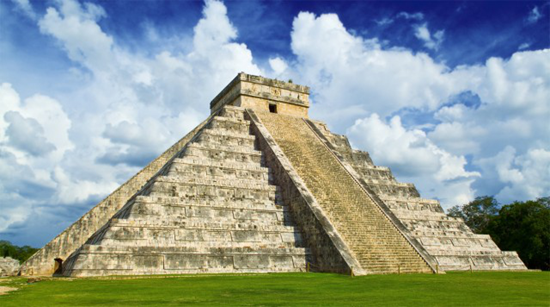
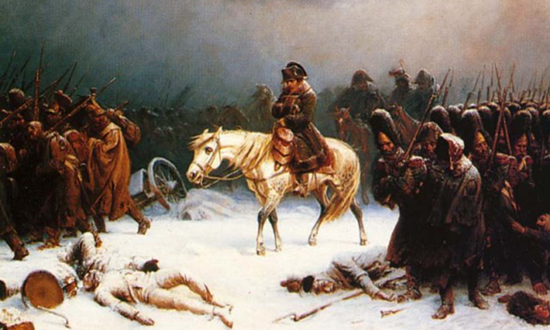
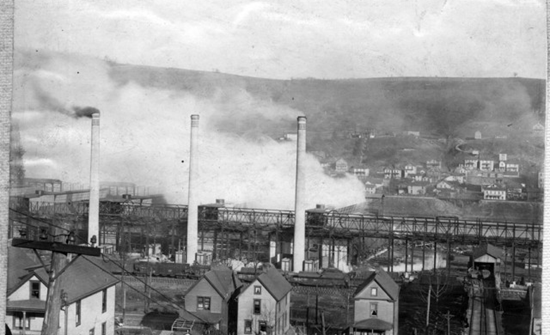
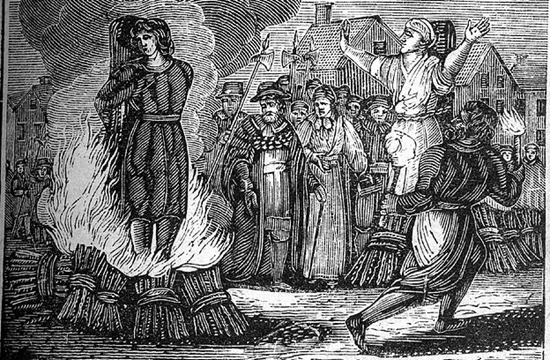
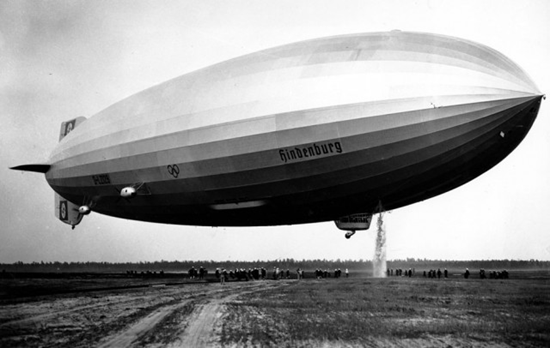

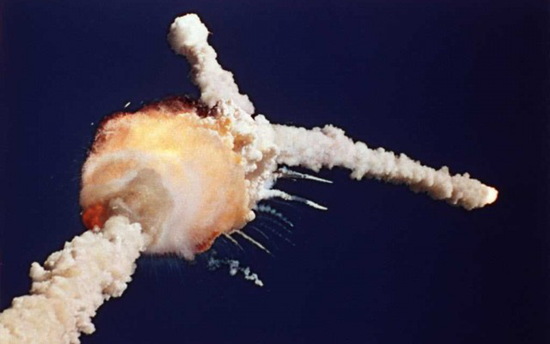

No comments:
Post a Comment
Please adhere to proper blog etiquette when posting your comments. This blog owner will exercise his absolution discretion in allowing or rejecting any comments that are deemed seditious, defamatory, libelous, racist, vulgar, insulting, and other remarks that exhibit similar characteristics. If you insist on using anonymous comments, please write your name or other IDs at the end of your message.